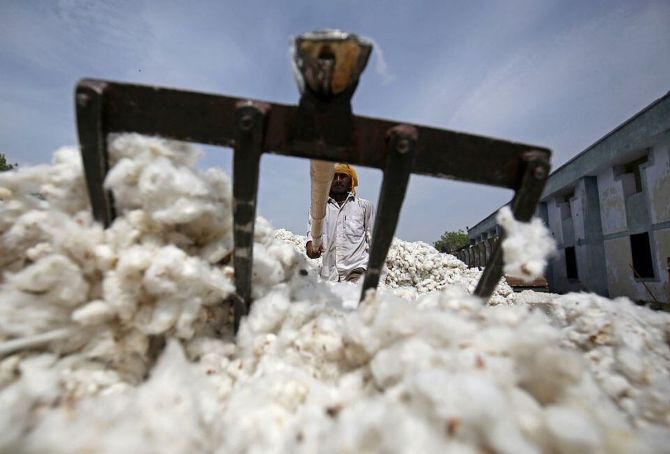A few days back, Atul Ganatra, president of the Cotton Association of India, presented a grim scenario of the crop’s prospects in the 2024-25 season that starts in October.

Addressing the association’s annual general meeting, Ganatra said the area under the crop could go down by at least 10 per cent in the coming season due to falling yields and realisation, leading to farmers losing interest.
The fear of a decline in acreage comes against the backdrop of India’s cotton production probably falling to its lowest in a decade, according to estimates.
After 2002, cotton output had jumped sharply due to increasing area under cultivation as well as the yield per hectare rising from 200 to 300 kg to 450-550 kg in a short few years, thanks to genetically modified Bt seeds.
Exports, too, started looking up, touching nearly 13 million bales in 2011-12 — the highest since 2000-01 (1 bale = 170 kg).
Imports dropped, and the country was on its way to becoming self-sufficient in cotton. Farmer incomes rose as Bt Cotton, while increasing the yield, also reduced the expenditure on pesticides.
Somewhere along the way, things started to fall apart at the seams.
Threat of the worm
“The Technology Mission on Cotton (TMC-I) launched by the Government during 2000-01 played an instrumental role in increasing both the yield and acreage of cotton cultivation…
"However, after the conclusion of TMC-I and in the lack of proper technological interventions and appropriate seed technology in the cotton sector, India’s cotton production declined,” the Confederation of Indian Textile Industry (CITI) said in a note shared with Business Standard.
Bhagirath Choudhary, founder and director of the South Asia Biotechnology Centre, Jodhpur, who has tracked the sector from close quarters, says in the last few years cotton production is passing through a phase of deceleration.
He adds that data variability, collective scientific ambiguity, and uncertainty on cotton trade policy, cotton seed price control, and low market prices are some of the factors fuelling the frustration among growers, ginners, yarn and textile manufacturers.
“The repeated outbreaks of pink bollworm across three cotton growing zones is another wakeup call,” says Choudhary.
The first outbreak of pink bollworm was reported in 2013-14, in Gujarat from where it has quickly spread. It is now one of the biggest threats to infect cotton farms in India and worldwide, and can inflict damage to the extent of 55 per cent and reduce seed cotton yield to an extent of 35 to 90 per cent.
It affects primarily the lint quality. Its infestation is reported to cause rosette flowers, flowers dropping, and premature opening of bolls resulting in stained immature fibre and deteriorate the quality of cotton production.
“It is our collective failure in the policy prescription at three levels, which resulted in the PBW developing the resistance to Bt protein,” Choudhury adds.
He lists the failures as non-implementation of refuge strategy (planting of non-Bt cotton around Bt cotton plot, rather than quickly adopting to Refuge-in-Bag strategy), lack of mandatory requirement for the expression of maximal Bt protein in approved Bt cotton hybrids, and finally, the approval of large numbers of Bt cotton hybrids, which made it difficult to inspect and maintain quality.
All these, according to Choudhury, are spiralling the cotton crisis into a fireball for rural communities that is threatening their income and livelihood.
Since 2002, no new Bt technology has been introduced in India for cotton, which has also spawned a big market for illegally developed Bt that is causing more harm to farmers.
The problems are not just in production; millers and ginners, who had embarked on a massive expansion drive, adding new spindles almost every year, are staring at a problem, as dipping domestic production is pushing up reliance on imports.
“It is a time to double our resolve to intensify research, increase investment, develop collaboration in real sense, and accelerate transfer of technology to address insurmountable challenge in cotton production system induced by climate change, tech fatigue, dwindling growers’ confidence, lack of tech approval and policy paralysis,” Choudhury says.
CITI, too, advocates a second Technology Mission on Cotton (TMC-2) that will rest on advanced seed technology (high yield and international fibre quality parameters — herbicide tolerant, high-density planting, Extra Long Staple cotton, drought tolerant, sucking pest tolerant, etc).
It also pressed for adopting global best practices for seed sowing, agronomy, harvesting, handling, ginning and pressing and a mission mode approach with sizable budget allocation for seed and agronomy technology, technology transfer, and clean cotton (least trash, low short fibre content and contamination free).
In June 2023, the regulator for GM crops, the Genetic Engineering Appraisal Committee, asked the developer of Bollgard-2 Roundup Ready (BG-2 RRF), Mahyco Private Ltd, to present a fresh dossier about the hybrids efficacy claims against certain targeted pests and also a new socio-economic analysis of them.
Experts in the field expressed the fear that it could further delay the commercialisation of the updated variant of Bt cotton at a time when illegally grown Bt has been flooding the market.
The regulator, though, approved field trials of other genetically engineered cotton hybrids having cry2Ai gene for resistance against pink bollworm.
Here, too, the progress was expected to be limited, as states where these trials are to be conducted were not keen to give the mandatory no-objection certificate.
Medium staple country
With the increased usage of Bt, India has largely become a medium-staple cotton country and extra staple cotton that goes into the production of high-value fabric needs to be imported.
Extra Long Staple (ELS) cotton is usually between 32 and 36 millimetre in length.
In India, out of the nearly 33 million bales of cotton produced in the 2022-23 season, which started in October last year, the majority is between 26 and 30 mm.
Of this, almost 80 per cent is 29 mm, which is considered medium-grade.
In India, out of the total domestic consumption of around 31 million bales, consumption of ELS cotton is just around 1 million bales.
As Choudhury explains, all Bt cotton hybrids are based either on medium staple length (24.5-25.5 mm) or long staple length (29.5-30.5 mm).
Extra Long Staple (32.5 mm) remains the niche, used to produce high-value fabrics.
CITI, meanwhile, said farmers were reluctant to grow ELS because of its limited market access.
“While government initiatives exist to promote its cultivation, the participation from the farming community is low so far because of many reasons,” it said.
Last year, the government came up with a pilot project on cotton to augment the supply of cotton, especially Extra Long Staple, with three technology interventions.
These include high-density planting and closer spacing planting in low-productivity areas, and a production technology for ELS cotton in niche areas under irrigated farming.
However, unless the first part of upgrading the technology is addressed, the other things might remain a pipe dream.











